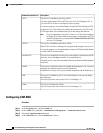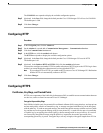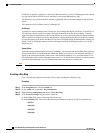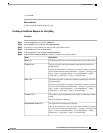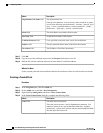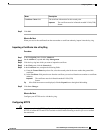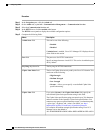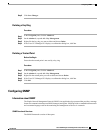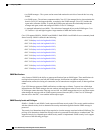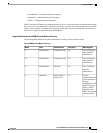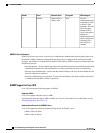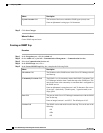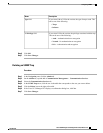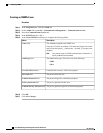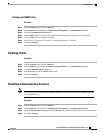
• An SNMP manager—The system used to control and monitor the activities of network devices using
SNMP.
• An SNMP agent—The software component within Cisco UCS, the managed device, that maintains the
data for Cisco UCS and reports the data, as needed, to the SNMP manager. Cisco UCS includes the
agent and a collection of MIBs. To enable the SNMP agent and create the relationship between the
manager and agent, enable and configure SNMP in Cisco UCS Manager.
• A managed information base (MIB)—The collection of managed objects on the SNMP agent. Cisco
UCS release 1.4(1) and higher support a larger number of MIBs than earlier releases.
Cisco UCS supports SNMPv1, SNMPv2c and SNMPv3. Both SNMPv1 and SNMPv2c use a community-based
form of security. SNMP is defined in the following:
• RFC 3410 (http://tools.ietf.org/html/rfc3410)
• RFC 3411 (http://tools.ietf.org/html/rfc3411)
• RFC 3412 (http://tools.ietf.org/html/rfc3412)
• RFC 3413 (http://tools.ietf.org/html/rfc3413)
• RFC 3414 (http://tools.ietf.org/html/rfc3414)
• RFC 3415 (http://tools.ietf.org/html/rfc3415)
• RFC 3416 (http://tools.ietf.org/html/rfc3416)
• RFC 3417 (http://tools.ietf.org/html/rfc3417)
• RFC 3418 (http://tools.ietf.org/html/rfc3418)
• RFC 3584 (http://tools.ietf.org/html/rfc3584)
SNMP Notifications
A key feature of SNMP is the ability to generate notifications from an SNMP agent. These notifications do
not require that requests be sent from the SNMP manager. Notifications can indicate improper user
authentication, restarts, the closing of a connection, loss of connection to a neighbor router, or other significant
events.
Cisco UCS Manager generates SNMP notifications as either traps or informs. Traps are less reliable than
informs because the SNMP manager does not send any acknowledgment when it receives a trap, and Cisco
UCS Manager cannot determine if the trap was received. An SNMP manager that receives an inform request
acknowledges the message with an SNMP response protocol data unit (PDU). If the Cisco UCS Manager
does not receive the PDU, it can send the inform request again.
SNMP Security Levels and Privileges
SNMPv1, SNMPv2c, and SNMPv3 each represent a different security model. The security model combines
with the selected security level to determine the security mechanism applied when the SNMP message is
processed.
The security level determines the privileges required to view the message associated with an SNMP trap. The
privilege level determines whether the message needs to be protected from disclosure or authenticated. The
supported security level depends upon which security model is implemented. SNMP security levels support
one or more of the following privileges:
Cisco UCS Manager GUI Configuration Guide, Release 2.0
122 OL-25712-04
Configuring SNMP



